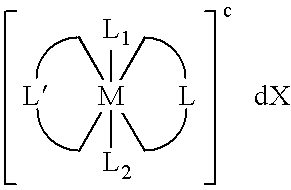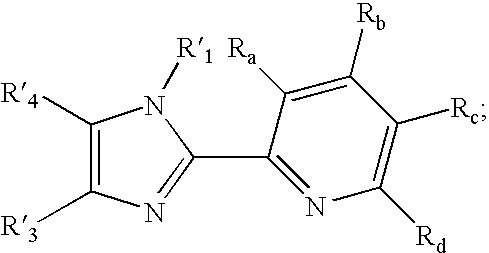Transition metal complexes with (pyridyl)imidazole ligands
a technology of pyridyl imidazole and complex metal, which is applied in the field of transition metal complexes with pyridyl imidazole ligands, can solve the problems of low solubility of redox mediators in test solutions, poor chemical, light, thermal and/or ph stability, and insufficient electron exchange with enzymes or electrodes. , to achieve the effect of facilitating electron transfer, rapid electron exchange and fast kinetics
- Summary
- Abstract
- Description
- Claims
- Application Information
AI Technical Summary
Benefits of technology
Problems solved by technology
Method used
Image
Examples
example 1
Synthesis of [Os(Py-MIM)2(MIM)Cl]2+2Cl—
[0052] By way of illustration, an example of the synthesis of [Os(Py-MIM)2(MIM)Cl]2+2Cl—, as illustrated below, is now provided.
Synthesis of 2-(2-pyridyl)imidazole
[0053] A solution of pyridine-2-carboxaldehyde (151.4g, 1.41 moles) and glyoxal (40% in H2O, 205 mL, 1.79 moles) in 300 mL of ethanol (EtOH) in a three-necked 1L round-bottom flask fitted with a thermometer and an addition funnel was stirred in an ice bath. When the solution was cooled to below 5° C., concentrated NH4OH (28-30%, 482 mL, 3.93 moles) was added dropwise through the addition funnel. The rate of the addition was controlled so that the temperature of the solution was maintained at below 5° C. After the addition, the stirring of the solution was continued in the ice bath for one hour and then at room temperature overnight. During the stirring process, the solution changed from light yellow to dark brown.
[0054] The solution was transferred to a 2L round bottom flask and ...
example 2
Synthesis of 1-phenyl-2-(2-pyridyl)imidazole
[0064] Further by way of illustration, an example of the synthesis of 1-phenyl-2-(2-pyridyl)imidazole, as illustrated below, is now provided. The example demonstrates how a 1-aryl-substituted 2-(2-pyridyl)imidazole is made from 1-(2-pyridyl)imidazole or its derivative, and an iodobenzene derivative (as illustrated) or a bromobenzene derivative.
[0065] 2-(2-pyridyl)imidazole (6.91 g), iodobenzene (11.47 g), Cs2CO3 (25 g), and copper powder (15g) were mixed in 60 mL anhydrous DMF in a 250 mL round bottom flask equipped with a magnetic stirrer and a reflux condenser. The mixture is degassed with N2 for 15 minutes at room temperature and then refluxed under N2 in an oil bath for 24 hours. The resulting mixture was cooled to room temperature and suction-filtered to remove the solid byproduct. The filtrate was extracted with EtOAc (3×100 μL). The combined organic layer was washed with H2O (2×100 μL) and then with saturated NaCl (2×150 mL), and...
PUM
| Property | Measurement | Unit |
|---|---|---|
| temperature | aaaaa | aaaaa |
| volume | aaaaa | aaaaa |
| volume | aaaaa | aaaaa |
Abstract
Description
Claims
Application Information
 Login to View More
Login to View More - R&D
- Intellectual Property
- Life Sciences
- Materials
- Tech Scout
- Unparalleled Data Quality
- Higher Quality Content
- 60% Fewer Hallucinations
Browse by: Latest US Patents, China's latest patents, Technical Efficacy Thesaurus, Application Domain, Technology Topic, Popular Technical Reports.
© 2025 PatSnap. All rights reserved.Legal|Privacy policy|Modern Slavery Act Transparency Statement|Sitemap|About US| Contact US: help@patsnap.com



